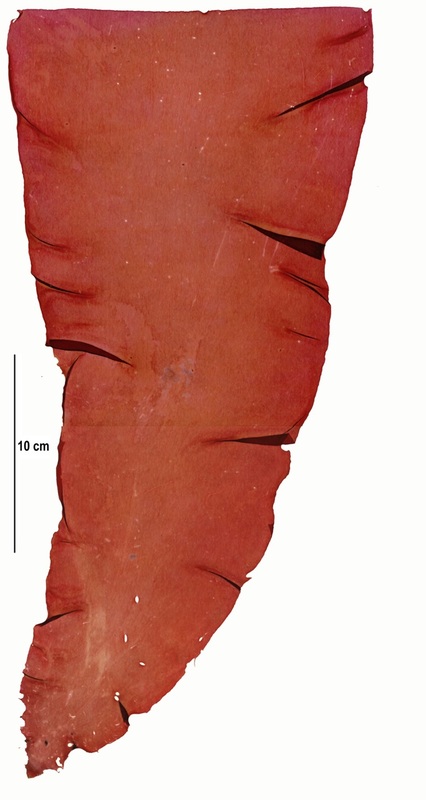Wildemania occidentalis, formerly Porphyra occidentalis
|
Specimen collection number PTM 405 in the UBC Herbarium Algae Database. Search the collection number in the database for more information on this specimen, or search the species for further occurrences. Image courtesy of Sandra Lindstrom.
|
Identification
This red seaweed has a reddish-pink strap-shaped (ligulate) blade. It is quite thin, measuring only 50-160 µm thick. It can grow over 2 m long. Habitat & Range Wildemania occidentalis grows on rock in the spring, summer, and autumn. It can be found in the low intertidal and subtidal, and has been recorded (as W. occidentalis or as Porphyra occidentalis) from British Columbia's Central Coast to Santa Cruz County, California. The specimen shown here and others also collected from Calvert Island were found growing on rock along semi-exposed shorelines. Similar Species Wildemania occidentalis was previously assigned to the genus Porphyra, as were Pyropia species). These red seaweeds are commonly known as nori, some of which are similarly reddish-pink, elongated, and thin. Some species found on the Central Coast are red cellophane (W. amplissima), which has a variable shape and ruffled edges; and Pyropia nereocystis, which only grows on bull kelp. |
References
Gabrielson, Paul W., Thomas Benjamin Widdowson, and Sandra C. Lindstrom. Keys to the seaweeds and seagrasses of southeast Alaska, British Columbia, Washington, and Oregon. No. 8. University of British Columbia, 2012.
Authors and editors
Kelly Fretwell (2016).
Gabrielson, Paul W., Thomas Benjamin Widdowson, and Sandra C. Lindstrom. Keys to the seaweeds and seagrasses of southeast Alaska, British Columbia, Washington, and Oregon. No. 8. University of British Columbia, 2012.
Authors and editors
Kelly Fretwell (2016).




